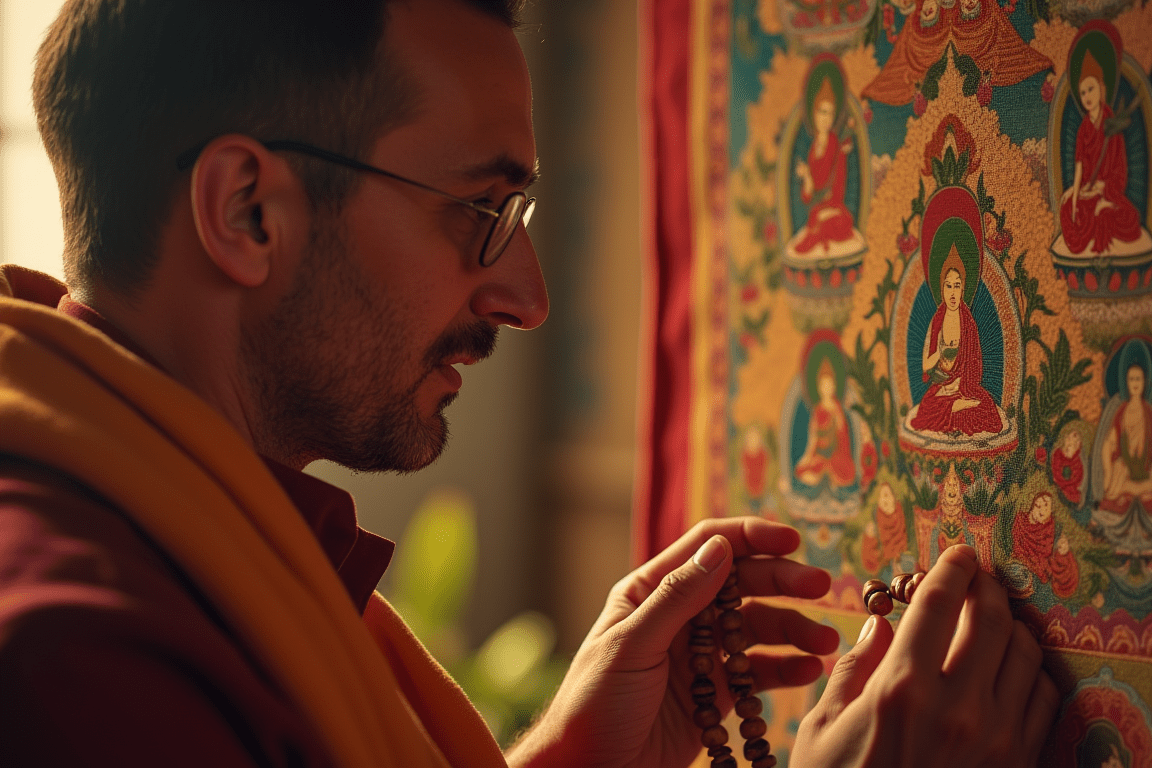
The Art and Spirit of Thangka: A Comprehensive Guide
1. What Is a Thangka?
Thangka (Tibetan: “thankga”) are traditional Tibetan scroll paintings depicting Buddhas, bodhisattvas, mandalas, and deities. Originally used as teaching aids and focal points for meditation, these richly colored artworks are painted or embroidered on cotton or silk and framed by decorative brocade borders.
2. A Brief History of Thangka
-
Origins in India and Tibet: Thangka art traces back to 7th‑century India and became firmly established in Tibet during the early Buddhist period (8th–9th centuries).
-
Monastic Production: For centuries, Tibetan monasteries maintained specialized Thangka studios, where skilled artists followed precise iconographic rules under the guidance of senior lamas.
-
Preservation of Lineage: Many Thangka designs adhere to lineages—Newar, Menri, and Khyenri—that differ in style, color palette, and embroidery techniques.
3. Common Themes & Symbolism
| Thangka Subject | Meaning & Purpose |
|---|---|
| Buddha Figures | Represent enlightenment, compassion, and teaching. |
| Bodhisattvas | Embody altruistic qualities like compassion (Avalokiteśvara) or wisdom (Manjushri). |
| Mandalas | Visual maps of the cosmos used in advanced meditation. |
| Protective Deities | Fierce forms like Six‑armed Mahākāla offer spiritual protection. |
| Medicine Buddhas | Green Tara or Bhaisajyaguru (Medicine Buddha) for healing rituals. |
Each figure’s posture, hand gestures (mudras), and color palette convey specific blessings and instructions for practice.
4. The Thangka Creation Process
-
Canvas Preparation: Cotton or silk cloth is stretched, sized with chalk, and coated with gesso.
-
Sketching & Proportion: Using grid guidelines, artists draw precise outlines according to sacred geometry.
-
Underpainting & Layering: Base colors are applied in stages, from background to foreground details.
-
Gold & Embroidery Accents: Many high‑end Thangkas use real gold leaf and silk embroidery to highlight halos, mantras, and deity robes.
-
Consecration Ritual: A senior lama performs a blessing ceremony—chanting mantras and sprinkling consecrated water—to infuse the Thangka with sacred power.
5. Modern Applications
-
Wall Art & Home Décor: Framed Thangka prints or mini Thangka tapestries add a spiritual focal point in living rooms, yoga studios, and meditation spaces.
-
Jewelry & Accessories: Thangka patterns inspire mini Thangka necklaces, Thangka‑pattern scarves, and Thangka accessory gifts—wearable art that carries symbolic meaning.
-
Digital & Mixed Media: Contemporary artists blend traditional motifs with abstract styles, creating art‑style Thangka pins and Thangka peace charms that appeal to global audiences.
6. How to Choose an Authentic Thangka
-
Materials & Craftsmanship: Genuine Thangka use natural pigments—lapis lazuli, cinnabar, malachite—and hand‑woven brocade. Machine‑printed reproductions lack depth and texture.
-
Artist Lineage & Certification: Look for information on the artist’s training and any monastery or cultural heritage certification.
-
Iconographic Accuracy: Authentic Thangka follow strict iconography; minor deviations may indicate a decorative reproduction rather than a ritual object.
-
Size & Portability: Mini Thangka wall art (8″×10″) works well for small spaces, while full‑size scrolls (24″×36″ and up) suit altars and galleries.
7. Display & Care Tips
-
Placement: Hang Thangka away from direct sunlight and moisture to preserve pigments and brocade fabric.
-
Rolling & Storage: When not displayed, roll the Thangka loosely around its top dowel, with the painted side inward, and store in a protective cloth cover.
-
Gentle Cleaning: Use a soft, dry brush to remove dust; avoid water or chemical cleaners.
8. The Spiritual Benefit of Thangka
For practitioners, Thangka serve as visual aids for meditation and prayer. Gazing at a Buddha Thangka cultivates devotion; tracing a mandala enhances focus. Even as decorative pieces, they invite mindfulness and serenity into modern interiors.
Whether you’re a collector, a spiritual seeker, or a lover of fine art, Thangka bridges ancient Himalayan wisdom and contemporary living. Explore our selection of Thangka wall art, mini Thangka necklaces, and hand‑painted Thangka pendants to enrich your space and spirit.
Discover authentic Thangka art at buddhabelief.com.





